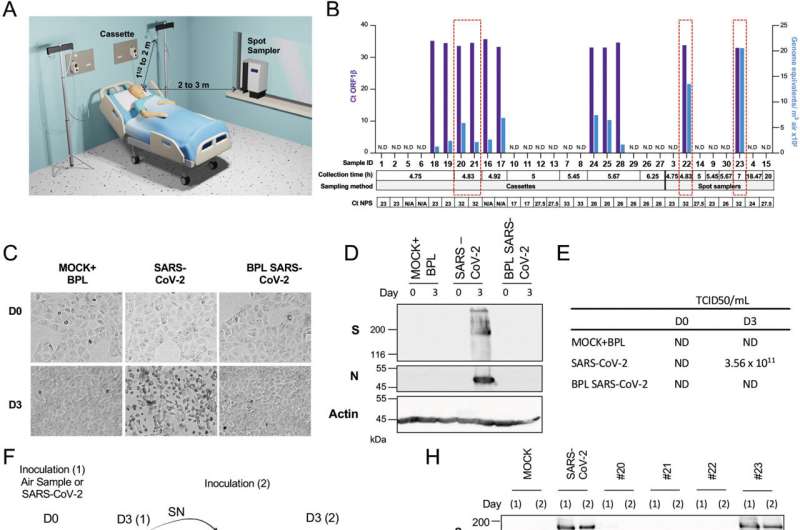This article has been reviewed according to Science X's editorial process and policies. Editors have highlighted the following attributes while ensuring the content's credibility:
fact-checked
proofread
Isolating infectious SARS-CoV-2 from hospital room air samples that were kept frozen for more than a year

Quebec scientists have succeeded in isolating infectious particles of the SARS-CoV-2 virus from air samples collected from hospital rooms of COVID-19 patients and kept frozen for more than a year, a new study shows.
The research was done by a team led by Nathalie Grandvaux, a researcher at the CHUM Research Centre (CRCHUM) and professor at Université de Montréal, in collaboration with the teams of Caroline Duchaine (Université Laval) and Yves Longtin (McGill University).
Published in Clinical Microbiology and Infection, the study provides insight into a scientific field that has been little explored since the beginning of the pandemic.
"In our study, we show through an experimental model that it is possible to isolate and cultivate infectious viruses from air samples," said Nathalie Grandvaux. "This is possible even if samples were collected over a year ago then frozen and stored before cell culture."
If public health authorities, including the World Health Organization, were slow to recognize airborne transmission of the virus, it is in part due to limited scientific evidence of the presence of infectious virus particles in aerosols.
"These studies are difficult to conduct," said Nathalie Grandvaux, "because you need to preserve the infectivity of the virus during collection, use the right cell culture techniques and have access to a level 3 containment laboratory, like the laboratory at the CRCHUM."
A unique method
Audray Fortin, a researcher on Nathalie Grandvaux's team and the first author of the study, developed a unique cell culture method to amplify traces of viruses collected by Caroline Duchaine, a Canadian bioaerosol specialist, and her team.
That was another scientific feat, requiring samplers—a series of collection devices placed inside the rooms of patients with COVID-19—that were used to maintain the virus infectivity and protect it during storage.
In all, 30 samples were collected during the study from 10 different rooms of patients with COVID-19, then stored frozen in a biobank for 14 months.
Using the aerosol samples from one patient's room, the team of scientists was able to identify the presence of replicating virus particles.
"Thanks to our method, it is yet possible to retrospectively evaluate the presence of infectious SARS-CoV-2 in samples collected during the different waves of the pandemic," said Nathalie Grandvaux. "This data will help us better understand the importance of airborne transmission of the virus and implement adapted preventive strategies."
Better prepared for the next pandemic
The findings can be used to prepare for the next pandemic, be it SARS-CoV-2 or another respiratory virus, she added.
"Our research should increase awareness of airborne infectious viruses. It argues for the importance of targeting airborne transmission in personal and collective protection measures, including by improving indoor air quality."
The collection and culture method can also be adapted to closed environments other than hospitals, such as schools, to test air quality and evaluate the effectiveness of protection measures against airborne transmission of viruses.
More information: Audray Fortin et al, Detection of viable SARS-CoV-2 in retrospective analysis of aerosol samples collected from hospital rooms of patients with COVID-19, Clinical Microbiology and Infection (2023). DOI: 10.1016/j.cmi.2023.03.019



















